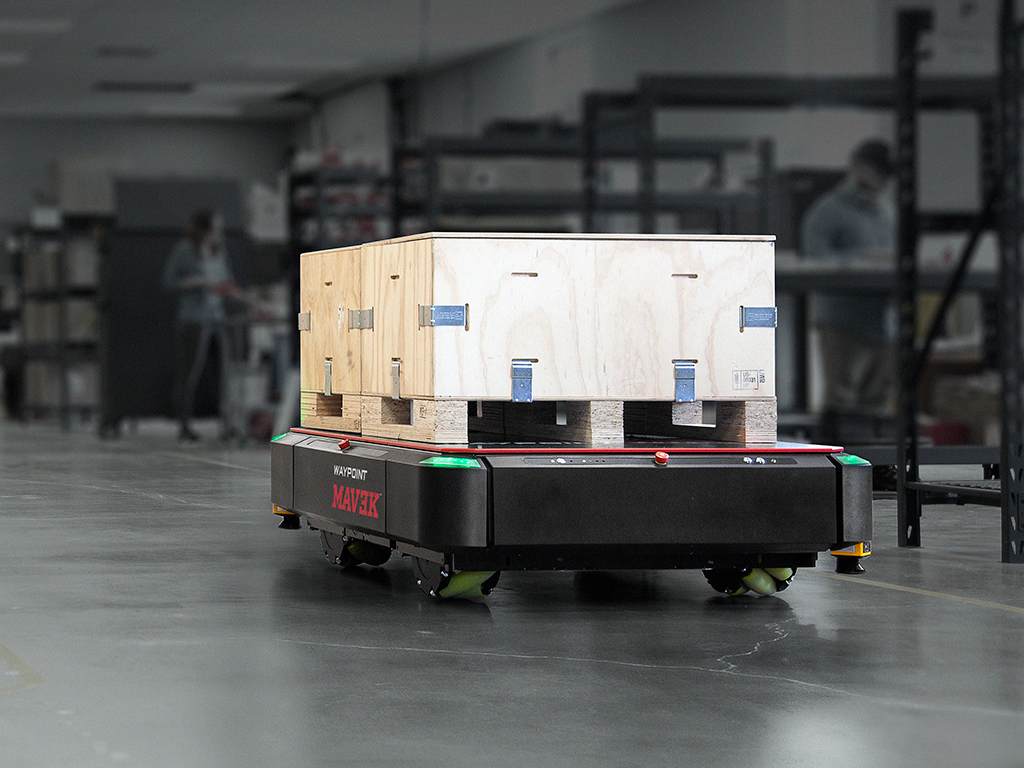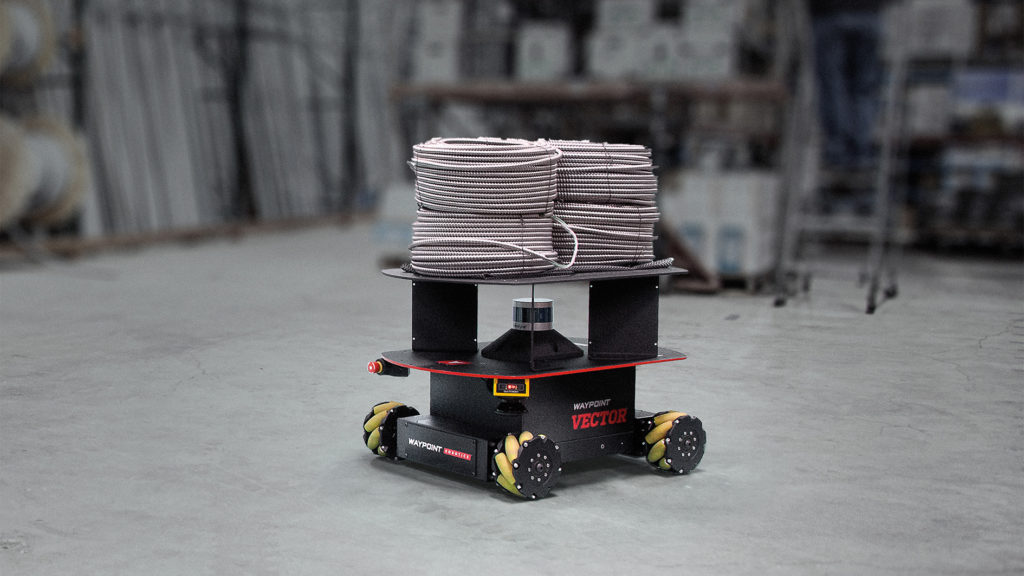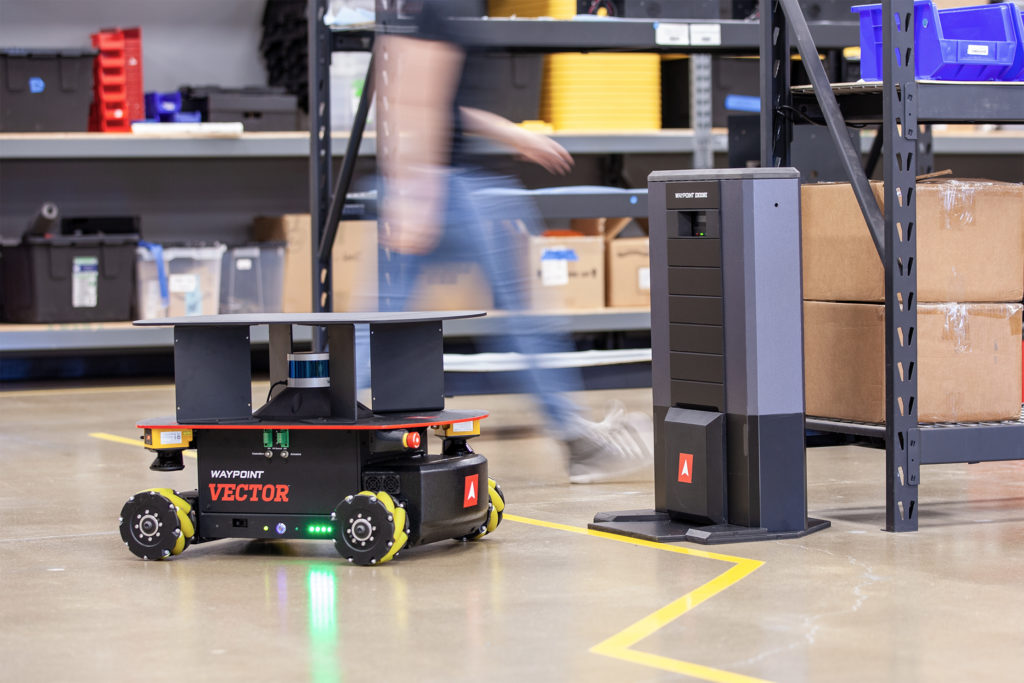
Waypoint Robotics Inc. and AHS LLC this week announced a new systems integrator partnership. The companies said that AHS will offer Waypoint’s fleet of omnidirectional mobile robots to its customer base.
AHS, or Advanced Handling Systems, has provided fulfillment and distribution solutions for a wide variety of industries and clients for more than 40 years. The Cincinnati-based company said it follows a six-step design-build process and can help improve employee productivity, order cycle times, and order accuracy.
Nashua, N.H.-based Waypoint Robotics said its Vector, MAV3K, and supporting products allow workers to delegate dull or arduous work to the robots so they can spend more time doing the interesting and valuable aspects of their jobs.
Waypoint Robotics also recently partnered with Numina Group and won a 2020 RBR50 innovation award for its MAV3K heavy-duty robot. The addition of Waypoint’s autonomous mobile robots (AMRs) to AHS’s line will enable it to offer fully integrated material handling systems, said the companies.
AHS is offering in-person and remote demonstrations of Waypoint AMRs at its Innovation Lab in Cincinnati, and Waypoint’s AMRs are now available for purchase. Dave Tavel, executive vice president at AHS, and Tim McCabe, director of business development at Waypoint, responded to the following questions from Collaborative Robotics Trends.
AHS, Waypoint describe collaboration
What led to Waypoint and AHS’s partnership? How did you find and evaluate each other?
Tavel: First and foremost is the cultural alignment of the organizations, secondly the technology and innovation that Waypoint brings to the market, and finally the fact that Waypoint is a domestic product, and support is enhanced due to the location and AHS’s market being North America.
McCabe: It was clear to us from the beginning that AHS had an exceptional team with the technical prowess and creative design to offer great solutions. We were even more impressed with the extraordinary care they take to serve their customers. We have a similar approach to both our design philosophy — building mobile robots that can be easily set up and used by workers on the job today — and towards our customers when consulting on projects or providing ongoing support.
How Waypoint stands out for AHS
How is Waypoint’s navigation technology a differentiator for the customers that AHS serves?
Tavel: Waypoint’s data capture is significantly faster than what is available in the market. Why is this important? This allows the robot to react quicker to multiple conditions. The obstacle avoidance is enhanced, and decisions are processed faster. Thus, the robot mission times are positively impacted.
Beyond the data capture using the cameras and scanners, the robot’s ability to use the omnidirectional capability makes this a two-pronged approach to speed and safety.
How do Waypoint’s AMRs complement the other mobile robots and collaborative robot arms that AHS provides? Which applications are they uniquely suited for?
McCabe: Waypoint AMRs have a couple of important differentiators: They’re “built tough” to withstand real-world industrial environments like manufacturing facilities or warehouses. They offer superior navigation, maintaining their localization for both dynamic environments or large open spaces. They have omnidirectional movement, which allows them to easily and quickly dock to workstations while offering a lot of flexibility for payload handling in tight environments.
And most importantly, they’re designed for the workforce, meaning they’re a productivity tool that workers can easily set up and operate immediately to help them do their jobs, and then they can easily make changes to the mission as their needs inevitably evolve.

Integration and training
Waypoint has provided its robots to manufacturers of all sizes. How much work is needed to integrate these systems with those of warehouses or distribution centers?
McCabe: Waypoint AMRs can be up and running, doing real work, the very first day on site. They have a very robust navigational system that does not require any infrastructure changes or additions like reflectors, bar codes, beacons, or special lighting. Waypoint’s control architecture does not even require a Wi-Fi or Internet connection to operate. Once given a mission, the AMR can execute the mission without having to receive directions from a centralized transport controller.
Some customers may connect their AMRs to their enterprise system — such as WMS, WCS, or MES [warehouse management system, warehouse control system, or manufacturing execution system] — to send commands directly to the AMRs via Wi-Fi.
Waypoint makes this WebSocket interface easy to develop and implement with its Dispatcher Cloud Simulator. Customers can develop and test their interfaces to our Dispatcher Cloud Sim, so when the AMRs arrive on site, they merely need to change the IP address to that of the physical robot, and they are off and running.
Will AHS be handling user training and support for Waypoint’s robots?
Tavel: As the relationship matures, AHS will be in a position to support the market with these services. AHS currently provides integration services for mobile robot applications. Part of that responsibility is the demand for user training.
One of the differentiators for Waypoint is the ease of use. Our initial hands-on with the Vector was very intuitive. We were up and going in less than 15 minutes.
McCabe: AHS is very experienced and well respected in the industry. They build close relationships with their customers, understand their customers’ business drivers, and act as a trusted advisor to meet evolving requirements.
AHS will manage these customer relationships, providing front-line training and support backed by Waypoint technical support engineers as needed.

Demand and availability
Has there been much demand yet for mobile manipulation, such as Waypoint’s CuffLink-RK offering?
McCabe: We’re seeing increasing interest for mobile manipulators. While customers have traditionally enhanced the transport functionality of AMRs with automatic loading or unloading of payloads with a lift module or conveyor deck, the integration of a cobot to an AMR provides a new level of use-case functionality and flexibility.
An example application could be a machine shop with longer machine cycle times. Parts delivery is required, but a dedicated cobot for machine tending may largely sit idle — and nobody can afford idle robots.
A mobile manipulator is a much more flexible and cost-effective solution that can both bring the parts to the machine and perform the machine tending across multiple machining centers. A good mobile manipulator solution will provide easy setup, quick and accurate docking, and have an option to provide shore power to the robot while it is working.
Our CuffLink product has seen a flurry of activity recently. It was originally developed for one of our mobile platform OEM customers to seamlessly integrate the Kinova arm and Robotiq‘s adaptive two-finger robotic gripper. Customers can source this CuffLink through Kinova or directly through us.
We’ve seen a rise in e-commerce demand and AMR deals during the COVID-19 pandemic. How has the novel coronavirus affected deployments among Waypoint and AHS’s customers?
Tavel: The demand for AMR technology had been growing prior to the pandemic based on labor and safety issues. Since the pandemic, our discussions with clients not only address the obvious, but now we are also discussing the ability to reduce people load within facilities. This certainly supports the need for social distancing as well as other benefits. Traditional ROI [return on investment] and business-case models are changing.
McCabe: The pandemic shutdowns certainly caused some companies to re-evaluate and delay some of their plans, but other in-process projects continued under the social distancing constraints. For example, we were able to install a warehouse fulfillment project remotely. Now we are seeing a little different slant on AMR project drivers, adding the objective of socially distancing to help companies get workers back on the job.


Leave a Reply
You must be logged in to post a comment.